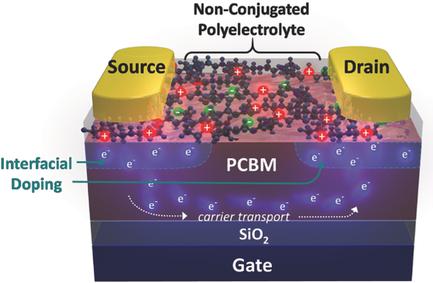当前位置:
X-MOL 学术
›
Adv. Electron. Mater.
›
论文详情
Our official English website, www.x-mol.net, welcomes your
feedback! (Note: you will need to create a separate account there.)
Improved Performance in n‐Type Organic Field‐Effect Transistors via Polyelectrolyte‐Mediated Interfacial Doping
Advanced Electronic Materials ( IF 5.3 ) Pub Date : 2017-09-18 , DOI: 10.1002/aelm.201700184 Yu Jung Park 1 , Myoung Joo Cha 1 , Yung Jin Yoon 2 , Shinuk Cho 3 , Jin Young Kim 2 , Jung Hwa Seo 1 , Bright Walker 2
Advanced Electronic Materials ( IF 5.3 ) Pub Date : 2017-09-18 , DOI: 10.1002/aelm.201700184 Yu Jung Park 1 , Myoung Joo Cha 1 , Yung Jin Yoon 2 , Shinuk Cho 3 , Jin Young Kim 2 , Jung Hwa Seo 1 , Bright Walker 2
Affiliation

|
To enhance electron injection in n‐type organic field‐effect transistors (OFETs), nonconjugated polyelectrolyte (NPE) layers are interposed between a [6,6]‐phenyl‐C61‐butyric acid methyl ester (PCBM) layer and Au electrodes. A series of NPEs based on an ethoxylated polyethylenimine backbone with various counterions, including Cl−, Br−, and I−, improve electron mobilities up to ≈10−2 cm2 V−1 s−1 and yield on–off ratios (Ion/Ioff) of 105 in PCBM OFETs. Ultraviolet photoelectron spectroscopy reveals that all of the NPEs lead to reduced electron injection barriers (φe) at the NPE/metal interface; this reduction in φe is consistent with dipole formation or n‐type doping at the electrode interface. Absorption measurements of PCBM films treated with NPEs are consistent with n‐doping of the PCBM. Regardless of the type of anion, thick NPE layers lead to high conductivity in the films independent of gate bias, whereas thin NPE layers lead to dramatically improved electron injection and performance. These results demonstrate that thin polyelectrolyte layers can be used to achieve controlled interfacial doping in organic semiconductors. Furthermore, this study provides valuable information about the function of NPEs, which may be exploited to improve device performance and to design new materials for future use in optoelectronic devices.
中文翻译:

通过聚电解质介导的界面掺杂提高n型有机场效应晶体管的性能
为了增强n型有机场效应晶体管(OFET)的电子注入,在[6,6]-苯基-C 61丁酸甲酯(PCBM)层和Au电极之间插入了非共轭聚电解质(NPE)层。一系列的NPE的基于乙氧基化的聚乙烯亚胺主链具有各种抗衡离子,包括氯- ,溴-和I - ,提高电子迁移率高达≈10 -2厘米2 V -1小号-1和产量的通断比(我开/我关)10 5在PCBM OFET中。紫外光电子能谱显示,所有在NPE的导致还原的电子注入势垒(φ Ë在NPE /金属界面); 本次减持中φ ë与偶极子形成或电极界面处的n型掺杂相一致。用NPE处理的PCBM膜的吸收测量与对PCBM的n掺杂一致。不管阴离子的类型如何,厚NPE层都会导致薄膜中的高电导率,而与栅极偏压无关,而NPE薄层会导致电子注入和性能得到显着改善。这些结果表明,薄的电解质层可用于实现有机半导体中受控的界面掺杂。此外,这项研究提供了有关NPE功能的有价值的信息,可以利用这些信息来改善设备性能并设计新材料以供将来在光电设备中使用。
更新日期:2017-09-18
中文翻译:

通过聚电解质介导的界面掺杂提高n型有机场效应晶体管的性能
为了增强n型有机场效应晶体管(OFET)的电子注入,在[6,6]-苯基-C 61丁酸甲酯(PCBM)层和Au电极之间插入了非共轭聚电解质(NPE)层。一系列的NPE的基于乙氧基化的聚乙烯亚胺主链具有各种抗衡离子,包括氯- ,溴-和I - ,提高电子迁移率高达≈10 -2厘米2 V -1小号-1和产量的通断比(我开/我关)10 5在PCBM OFET中。紫外光电子能谱显示,所有在NPE的导致还原的电子注入势垒(φ Ë在NPE /金属界面); 本次减持中φ ë与偶极子形成或电极界面处的n型掺杂相一致。用NPE处理的PCBM膜的吸收测量与对PCBM的n掺杂一致。不管阴离子的类型如何,厚NPE层都会导致薄膜中的高电导率,而与栅极偏压无关,而NPE薄层会导致电子注入和性能得到显着改善。这些结果表明,薄的电解质层可用于实现有机半导体中受控的界面掺杂。此外,这项研究提供了有关NPE功能的有价值的信息,可以利用这些信息来改善设备性能并设计新材料以供将来在光电设备中使用。











































 京公网安备 11010802027423号
京公网安备 11010802027423号